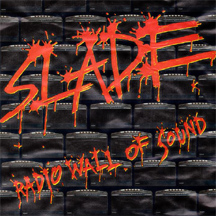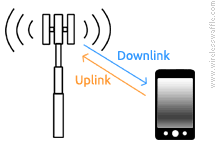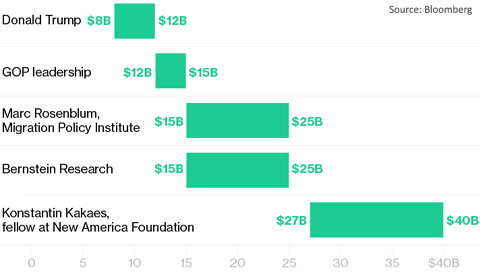Since his election as President of the United States, one of Donald Trump's key programmes has been the construction of a wall along the border with Mexico. Many people believe that the purpose of such a wall is to reduce illegal immigration along the border and to stop goods being illegally transported between the two countries without clearing the necessary customs.
 Wireless Waffle has discovered, however, that the reason for the construction of the wall is nothing to do with immigration or customs but is needed to prevent transmissions from mobile base stations using the 700 MHz band in Mexico from interfering with mobile base stations in the 700 MHz band in the USA.
Wireless Waffle has discovered, however, that the reason for the construction of the wall is nothing to do with immigration or customs but is needed to prevent transmissions from mobile base stations using the 700 MHz band in Mexico from interfering with mobile base stations in the 700 MHz band in the USA.
It is often said that radio signals do not respect international borders: signals from one country do not abruptly stop when they reach an arbitrary line on a map. As such, signals from mobile base stations in border areas are prone to cause interference to base stations on the opposite side of the border. Several European countries have reached an agreement (known as the HCM Agreement) which defines how much cross-border 'overspill' is permitted.
In general when signals cross borders, the use of the radio spectrum either side of the border is similar, that is to say that if the frequencies are used on one side for base station transmissions, it will be used on the other side for the same purpose. For example, if the signals from one country's mobile base stations are roughly the same strength along the border as those from its neighbour, and assuming that a mobile handset will latch onto the strongest signal, as it passes from one country to the next, it will automatically select the network for the country in which it is located.
 The worst case situation is where the transmitters on one side of the border (the 'downlink') which are typically 1000 Watts or more for a mobile base station are on the same frequencies as the receivers on the other (the 'uplink') which are trying to receive signals from mobile handsets with 1 Watt of power who are several miles away. This is akin to having someone in one country shouting directly into the ear of someone standing next to them who is simulatneously trying to hear one of their own residents whispering to them from a great distance. No manner of technological development will solve this problem and hence neighbouring countries try and avoid this happening.
The worst case situation is where the transmitters on one side of the border (the 'downlink') which are typically 1000 Watts or more for a mobile base station are on the same frequencies as the receivers on the other (the 'uplink') which are trying to receive signals from mobile handsets with 1 Watt of power who are several miles away. This is akin to having someone in one country shouting directly into the ear of someone standing next to them who is simulatneously trying to hear one of their own residents whispering to them from a great distance. No manner of technological development will solve this problem and hence neighbouring countries try and avoid this happening.
Between the US and Mexico in the 700 MHz band, however, this situation arises. The diagram below shows how the frequencies in this mobile band are used in either country. A downlink (mobile base station transmission) on the same frequency as an uplink (mobile base station receive) will cause exactly the kind of problems identified above.

So... the base stations in the 'lower 700 MHz band' in the USA will cause immense interference to the base stations in Mexico operating at the upper end of the Mexican 700 MHz band, and the base stations in Mexico will cause immense interference to the 'upper 700 MHz band' base stations in the USA.
 There is no straightforward solution to this problem, other than one or other country adopting the same frequency plan as its neighbour. As both countries already have services operating in the bands, this is beyond unlikely. The only way to overcome such a problem is therefore to try and stop signals from one side of the border reaching the other side. The laws of physics dictate that the only way to do this is to build a barrier that is impervious to radio signals, such as, for example, a tall metallic wall (or one with metal running up the inside). Metal boxes known as Faraday cages are used in laboratories (and sci-fi movies) to perform just this task.
There is no straightforward solution to this problem, other than one or other country adopting the same frequency plan as its neighbour. As both countries already have services operating in the bands, this is beyond unlikely. The only way to overcome such a problem is therefore to try and stop signals from one side of the border reaching the other side. The laws of physics dictate that the only way to do this is to build a barrier that is impervious to radio signals, such as, for example, a tall metallic wall (or one with metal running up the inside). Metal boxes known as Faraday cages are used in laboratories (and sci-fi movies) to perform just this task.

The 700 MHz band was sold at auction in the USA for US$19 billion in 2008. Estimates of the cost of the wall vary, but the mean value is around US$20 billion. This is no co-incidence. Having paid US$19 billion for the spectrum in the 700 MHz band, the US operators have a reasonable expectation that they can use the frequencies without undue interference and thus a 'Faraday Wall' is necessary. As long as Mr Trump can build it for less than US$19 billion, the operators will be happy, and the Federal Reserve will still have made a small profit on the sale of the spectrum. Win-win as they say.
 Wireless Waffle has discovered, however, that the reason for the construction of the wall is nothing to do with immigration or customs but is needed to prevent transmissions from mobile base stations using the 700 MHz band in Mexico from interfering with mobile base stations in the 700 MHz band in the USA.
Wireless Waffle has discovered, however, that the reason for the construction of the wall is nothing to do with immigration or customs but is needed to prevent transmissions from mobile base stations using the 700 MHz band in Mexico from interfering with mobile base stations in the 700 MHz band in the USA.It is often said that radio signals do not respect international borders: signals from one country do not abruptly stop when they reach an arbitrary line on a map. As such, signals from mobile base stations in border areas are prone to cause interference to base stations on the opposite side of the border. Several European countries have reached an agreement (known as the HCM Agreement) which defines how much cross-border 'overspill' is permitted.
In general when signals cross borders, the use of the radio spectrum either side of the border is similar, that is to say that if the frequencies are used on one side for base station transmissions, it will be used on the other side for the same purpose. For example, if the signals from one country's mobile base stations are roughly the same strength along the border as those from its neighbour, and assuming that a mobile handset will latch onto the strongest signal, as it passes from one country to the next, it will automatically select the network for the country in which it is located.
 The worst case situation is where the transmitters on one side of the border (the 'downlink') which are typically 1000 Watts or more for a mobile base station are on the same frequencies as the receivers on the other (the 'uplink') which are trying to receive signals from mobile handsets with 1 Watt of power who are several miles away. This is akin to having someone in one country shouting directly into the ear of someone standing next to them who is simulatneously trying to hear one of their own residents whispering to them from a great distance. No manner of technological development will solve this problem and hence neighbouring countries try and avoid this happening.
The worst case situation is where the transmitters on one side of the border (the 'downlink') which are typically 1000 Watts or more for a mobile base station are on the same frequencies as the receivers on the other (the 'uplink') which are trying to receive signals from mobile handsets with 1 Watt of power who are several miles away. This is akin to having someone in one country shouting directly into the ear of someone standing next to them who is simulatneously trying to hear one of their own residents whispering to them from a great distance. No manner of technological development will solve this problem and hence neighbouring countries try and avoid this happening. Between the US and Mexico in the 700 MHz band, however, this situation arises. The diagram below shows how the frequencies in this mobile band are used in either country. A downlink (mobile base station transmission) on the same frequency as an uplink (mobile base station receive) will cause exactly the kind of problems identified above.

So... the base stations in the 'lower 700 MHz band' in the USA will cause immense interference to the base stations in Mexico operating at the upper end of the Mexican 700 MHz band, and the base stations in Mexico will cause immense interference to the 'upper 700 MHz band' base stations in the USA.
 There is no straightforward solution to this problem, other than one or other country adopting the same frequency plan as its neighbour. As both countries already have services operating in the bands, this is beyond unlikely. The only way to overcome such a problem is therefore to try and stop signals from one side of the border reaching the other side. The laws of physics dictate that the only way to do this is to build a barrier that is impervious to radio signals, such as, for example, a tall metallic wall (or one with metal running up the inside). Metal boxes known as Faraday cages are used in laboratories (and sci-fi movies) to perform just this task.
There is no straightforward solution to this problem, other than one or other country adopting the same frequency plan as its neighbour. As both countries already have services operating in the bands, this is beyond unlikely. The only way to overcome such a problem is therefore to try and stop signals from one side of the border reaching the other side. The laws of physics dictate that the only way to do this is to build a barrier that is impervious to radio signals, such as, for example, a tall metallic wall (or one with metal running up the inside). Metal boxes known as Faraday cages are used in laboratories (and sci-fi movies) to perform just this task. 
The 700 MHz band was sold at auction in the USA for US$19 billion in 2008. Estimates of the cost of the wall vary, but the mean value is around US$20 billion. This is no co-incidence. Having paid US$19 billion for the spectrum in the 700 MHz band, the US operators have a reasonable expectation that they can use the frequencies without undue interference and thus a 'Faraday Wall' is necessary. As long as Mr Trump can build it for less than US$19 billion, the operators will be happy, and the Federal Reserve will still have made a small profit on the sale of the spectrum. Win-win as they say.
1 comment
( 914 views )
| permalink
| 



 ( 3 / 42993 )
( 3 / 42993 )




 ( 3 / 42993 )
( 3 / 42993 )
Saturday 27 January, 2018, 09:04 - Spectrum Management, Much Ado About Nothing
Posted by Administrator
It seems that we, here at Wireless Waffle are having a bit of a spate of 'told you so' type events at the moment. Last month we spotted that Vodafone had been rapped over the knuckles for their crafty roaming fee shenanigans. Now we have spotted that Ofcom have been called out to assist drivers who couldn't lock or unlock their cars due to radio interference.Posted by Administrator
 On various occasions we have discussed how straightforward and relatively widespread the jamming of the frequencies used for your car keyfob is. Last time we discussed this it was because some miscreants had latched onto the idea and were stopping people locking their cars so that they could easily break in (more like stroll in) and take whatever they found in the glove compartments, foot wells and boots of the rich and not-so-rich.
On various occasions we have discussed how straightforward and relatively widespread the jamming of the frequencies used for your car keyfob is. Last time we discussed this it was because some miscreants had latched onto the idea and were stopping people locking their cars so that they could easily break in (more like stroll in) and take whatever they found in the glove compartments, foot wells and boots of the rich and not-so-rich. The Ofcom story is even more worrying as it suggests that jamming these devices is far easier than even we though possible. In addition to the car keyfobs we are so keen on discussing, the same frequency range (433 MHz) is also used for a wide variety of other wireless devices including wireless doorbells. These devices are relatively low power (10 milliWatts) and the idea is that they shouldn't interfere with each other as the range of transmission is very small. It seems, however, that a button on one such doorbell got stuck in the 'on' position, meaning it was constantly transmitting. This was enough to stop people in the vacinity locking and unlocking their cars. Thankfully, the brave Ofcom engineers were able to track down the problem and sanity was restored. Hurrah for Ofcom!
The Ofcom story is even more worrying as it suggests that jamming these devices is far easier than even we though possible. In addition to the car keyfobs we are so keen on discussing, the same frequency range (433 MHz) is also used for a wide variety of other wireless devices including wireless doorbells. These devices are relatively low power (10 milliWatts) and the idea is that they shouldn't interfere with each other as the range of transmission is very small. It seems, however, that a button on one such doorbell got stuck in the 'on' position, meaning it was constantly transmitting. This was enough to stop people in the vacinity locking and unlocking their cars. Thankfully, the brave Ofcom engineers were able to track down the problem and sanity was restored. Hurrah for Ofcom!Far be it for us to opine on the implications of this, but taking the earlier example from the BBC in which miscreants were jamming car locks but haven't Ofcom just provided these folk (and others with a similar inclination) with a simple, cheap and undetectable means of achieving the same outcome?
Just get hold of the push-button part of a wireless doorbell, put this in your pocket, and wander around a car park where posh cars park (maybe even buy a hi-viz jacket so it looks as if you are meant to be there). If it's a supermarket car park, collect a few trollies whilst you're waiting. When a particularly rich looking owner appears, go and stand close to their car and as they get out and get ready to press the button on their key to lock it, activate the wireless doorbell button. 'Hey presto', the car won't lock and you will be able to help yourself to their Gucci loafers and other luxury goodies.
From a radio spectrum management and perhaps more specifically a Wireless Telegraphy Act perspective, no law has been broken. From a Theft Act perspective, however, you still stand to be charged (or sit, depending on the layout of the court room).
Thanks Ofcom!

Posted using my gold-plated iPhone X, whilst wearing Gucci loafers and sipping Bollinger RD '85 on my luxury yacht moored in Saint Tropez with my 3 Aston Martins parked alongside.
Saturday 23 December, 2017, 18:01 - Spectrum Management
Posted by Administrator
Back in June of last year, Wireless Waffle discussed the fact that Vodafone had hiked their roaming charges in a number of countries, making even a simple text message cost a fiver or more.Posted by Administrator
 It seems that we were not the only ones to notice this but that the powers that be took a dim view of it as well. As a result, Vodafone has been forced by the telecoms regulator Ofcom to allow its customers to end their contracts early, if they had been duped into the roaming scam.
It seems that we were not the only ones to notice this but that the powers that be took a dim view of it as well. As a result, Vodafone has been forced by the telecoms regulator Ofcom to allow its customers to end their contracts early, if they had been duped into the roaming scam.On the one hand it's hard to feel sorry for Vodafone for sneaking in these additional roaming charges, when it was faced with a total loss of roaming income from anyone going to Europe as a result of European Commission Decision (EU) 2016/2286 which forces all EU mobile operators to abolish roaming charges between Member states, often dubbed the 'roam like at home' decision. On the other hand, it was a pretty underhand move, especially as the only notice that some Vodafone customers had was a text message - and who bothers to read text messages from their operators?
Tuesday 21 November, 2017, 10:27 - Broadcasting, Licensed, Spectrum Management
Posted by Administrator
Posted by Administrator
 Digital UK, the organisation responsible for promoting digital terrestrial television in the UK, has recently published a white paper it commissioned from consultants Aetha and Webb Search entitled 'The defragmentation dividend: A more efficient use of the UHF band'. The paper hypothesises that by re-organising the UHF (e.g. sub 1 GHz) spectrum available to mobile operators, it would be possible to use it more efficiently and deliver more service from the same amount of spectrum.
Digital UK, the organisation responsible for promoting digital terrestrial television in the UK, has recently published a white paper it commissioned from consultants Aetha and Webb Search entitled 'The defragmentation dividend: A more efficient use of the UHF band'. The paper hypothesises that by re-organising the UHF (e.g. sub 1 GHz) spectrum available to mobile operators, it would be possible to use it more efficiently and deliver more service from the same amount of spectrum.The paper identifies the fact that, at present, the 'digital dividend' spectrum (e.g. that which has been released from television broadcasting due to the increased efficiency of digital transmission over its old analogue counterpart), is broken up into a number of fragmented pieces whose usage is not optimum. This is certainly true: the figure below shows the current set of allocations within the frequency range 694 - 960 MHz.

The mobile allocations at present are as follows:
| Band | Uplink (MHz) | Downlink (MHz) | Amount (MHz) | Notes |
|---|---|---|---|---|
| 900 MHz | 876-915 | 921-960 | 78 | Including GSM-R |
| 800 MHz | 832-862 | 791-821 | 60 | |
| 700 MHz (a) | 703-733 | 758-788 | 60 | FDD |
| 700 MHz (b) | 738-753 | 15 | TDD or Downlink | |
| TOTAL | 213 | |||
In addition there is approximately 29 MHz set-aside for short-range devices. Thus, of the total of 266 MHz of spectrum between 694 and 960 MHz, 213 MHz (80%) is allocated to mobile services, 29 MHz (11%) for short-range devices leaving 24 MHz (9%) 'empty' (mostly for guard-bands to protect services on adjacent frequencies from interfering with each other). The theory is that by re-arranging the band, it is possible to use all of the small gaps that currently exist between the various mobile allocations (e.g. the 9% that is empty) for more mobile services.
One of the problems of the plans proposed in the report is that although they increase the amount of spectrum for mobile services to up to 250 MHz in their most extreme case, they also reduce the amount available for short-range devices from 29 MHz to just 16 MHz. Whilst you may be thinking, "isn't mobile a better use of spectrum than short-range devices", the fact is that an increasingly wide ecosystem of devices is supported in this spectrum. It includes radiomicrophones and wireless headphones but perhaps even more critically, a growing number of Internet of Things (IoT) technologies that are seen by many as being at the centre of the next stages in the development of the Internet. This includes sensors (e.g. thermostats, light sensors), smart meters (electricity, gas and water) and a wide range of smart-city applications such as transport management. Digital UK's proposed plans involve changing the frequencies used by these devices, which is notoriously difficult. How long, for example, do the keyfobs that unlock your car door last - as long as the vehicle itself in most cases. So clearing a short-range device frequency won't be completed until every device in a band has been replaced by a new one.
The report only pays passing comment to the new 600 MHz mobile band that is being implemented in the USA. In fact, the report seems to suggest that even its most conservative re-organisation option would release so much capacity that there would be no need for the 600 MHz band:
...even the more modest increase of 25% in Option 1 would be similar to the capacity that could be provided by repurposing the 600MHz band...
 It makes this claim as a result of an oddity of current mobile technology, in which the amount of spectrum (and capacity) that is available to a mobile user is roughly equally split in the uplink and downlink directions (e.g. to the network from the user, and from the network to the user respectively). If the band was re-purposed as Time Division Duplex (TDD), the share of uplink and downlink capacity can be changed, and the report assumes that 80% of overall capacity would be made available for downlink and 20% for uplink (this is in fact in line with current estimates of the real split of usage). If this is the crux of the argument, then doing nothing at all to actually change the overall amount of mobile capacity available, but changing all of the existing allocations to TDD would approximately yield a 60% 'improvement' in downlink capacity, but this would be to the loss of uplink capacity which would fall by 250%! There is no gain without pain. In addition, TDD operators in adjacent mobile spectrum need to fully synchronise their networks otherwise there needs to be a guard-band between them, reducing the overall efficiency of use and opening up new gaps.
It makes this claim as a result of an oddity of current mobile technology, in which the amount of spectrum (and capacity) that is available to a mobile user is roughly equally split in the uplink and downlink directions (e.g. to the network from the user, and from the network to the user respectively). If the band was re-purposed as Time Division Duplex (TDD), the share of uplink and downlink capacity can be changed, and the report assumes that 80% of overall capacity would be made available for downlink and 20% for uplink (this is in fact in line with current estimates of the real split of usage). If this is the crux of the argument, then doing nothing at all to actually change the overall amount of mobile capacity available, but changing all of the existing allocations to TDD would approximately yield a 60% 'improvement' in downlink capacity, but this would be to the loss of uplink capacity which would fall by 250%! There is no gain without pain. In addition, TDD operators in adjacent mobile spectrum need to fully synchronise their networks otherwise there needs to be a guard-band between them, reducing the overall efficiency of use and opening up new gaps.Whilst the report makes a valid argument about whether the future of mobile should be TDD or FDD, it is perhaps no surprise that it chooses this solution to theorise about an improvement in the efficiency of use of UHF spectrum, over and above the use of the new 600 MHz band, whose use would obviously entail the loss of (yet) more spectrum for digital terrestrial television. Sadly for Digital UK, the required pain, in terms of re-organising existing mobile networks, and replacing all short-range devices is sadly never going to counterbalance the gain of a few extra MHz of UHF spectrum.

